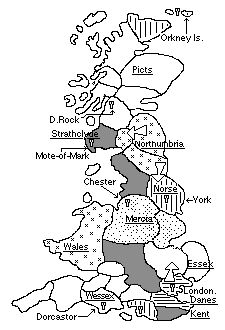 Bretwalda
Bretwalda Bretwalda
Bretwaldaby Mike Demana (article originally appeared in The Herald #28)
The long summer days of the north rang with the sound of hammering. The Picts, their armies a riot of tartan color in the lingering sun, tightened their siege lines around two of Strathclyde's major fortresses. In July, after eight months of siege, the Briton capital of Dumbarton Rock finally fell. King Christian Ravenhawk escaped to the hills, vowing to raise an army to break the siege of Mote-of-Mark, which still held out after four months. His brave words received a cold dash when word arrived that last year's conquest, the province of Dumfries, had been retaken by his old enemy, Northumbria.
The days of confusion in Northumbria seemed over. A second Anglian army marched to lay siege to the mighty walls of York -- lost to the Norsemen last year. The Norse jarl ruled the city with an iron hand, though, and it held out all summer. The jarl knew it had to, for the dragonships were seeking prey elsewhere. The Orkney island capital of Kirkwall fell to a Norse assault that followed three months of siege. The garrison was slaughtered. As summer drew to a close, the Vikings boarded their longships and sailed from the island, unaware that both the Pict and Strathclyde navies had launched their fleets, too. In the south, the Norse continued to harass the coasts of Britain. They redoubled their sieges of Kentish Chichester and Wessex Dorcastor. In July, Chichester fell to another assault, making Sussex the third province in Britain they ruled.
 The Danes
startled their Kentish besiegers at Rochester and marched out for battle.
Their ferocity was too much for the Saxon fyrd, and they were driven from
the field in rout. Eorl Aelfred proved his worth to his king, though, thawing
the ice from his men's veins and infusing it with steel. On the way home,
they brushed aside a smaller Danish force that had besieged Dover. Aelfred
vowed he and his army would not run from the Vikings again -- they knew
the mettle of their foe, now. So, when the Danish main army marched north
to Londinium, chasing off the East Saxon army that had been trying to retake
its capital, Aelfred followed. When the Danes invaded Essex's Saeten, he
besieged Canterbury in North Kent. A stubborn man of a stubborn people,
Aelfred proclaimed Kent would withstand the Vikings.
The Danes
startled their Kentish besiegers at Rochester and marched out for battle.
Their ferocity was too much for the Saxon fyrd, and they were driven from
the field in rout. Eorl Aelfred proved his worth to his king, though, thawing
the ice from his men's veins and infusing it with steel. On the way home,
they brushed aside a smaller Danish force that had besieged Dover. Aelfred
vowed he and his army would not run from the Vikings again -- they knew
the mettle of their foe, now. So, when the Danish main army marched north
to Londinium, chasing off the East Saxon army that had been trying to retake
its capital, Aelfred followed. When the Danes invaded Essex's Saeten, he
besieged Canterbury in North Kent. A stubborn man of a stubborn people,
Aelfred proclaimed Kent would withstand the Vikings.
While some kingdoms worried about their survival, King Egbert of Wessex dreamed of dominion. His armies flexed his kingdom's muscle by smashing the forces of Mercia and chasing them into the bogs of Lindsey. In the south, a scraped-together host broke the Norse siege of Dorcaster and drove the invaders out to sea. Meanwhile, his siege of the old Roman city of Chester, one of Mercia's last fortresses in the center of England, dragged on into its fourth month.
Summer of 817 A.D. saw two bears well awake from slumber in Britain -- one in the north in the form of the tattooed Picts, and another in the south, the mighty Wessex. Vipers hissed their challenges, the Vikings and now the Northumbrians, but the bears appeared ready to shoulder aside the other kingdoms in vying for dominance on the island.